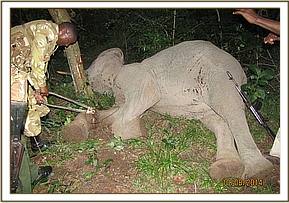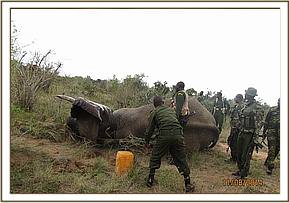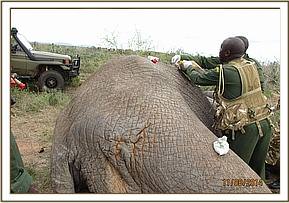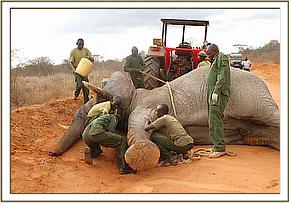Introduction The August weather was cool and dry like most times of the season with large numbers of elephants thronging the artificial water points to quench their thirst
Introduction
The August weather was cool and dry like most times of the season with large numbers of elephants thronging the artificial water points to quench their thirst. The long distances they cover from foraging to watering points leads to exhaustion and sometimes deaths of young calves of which we haven’t experienced this year. Cases handled this month includes desnaring of a young elephant bull in Shimba hills, treatment of a bull with arrow wound near Murondo fence line and another bull in Ithumba. Other species included a snared impala treated near Tsavo east park headquarters.
Case #1 Desnaring of an elephant:
Date: 10th August 2014 Species: African elephant (Loxodanta Africana) Sex: Male Age: Sub adult Location: Shimba hills national reserve
History: The elephant was spotted by rangers with a wire snare around its foreleg along the Kwale-Kinango road inside the reserve and reported to the vet office. Previous two attempts to trace him failed but finally found beside the road on the second attempt.
Immobilization, examination and treatment: The elephant was immobilized using 16 mgs of etorphine propelled in a dan inject dart system. He ran into the forest and fell about a hundred metres away. The search was conducted and he was found before darkness fell. The wire snare was cut loose, wounds cleaned with hydrogen peroxide mixed in water and later doused with tincture of iodine. Green clay was used to cover the wound. Injenctable dexamethasone and long acting amoxicillin were administered parenterally. He was revived by administration of 48 mgs of diprenorphine intravenously. Prognosis: Good.


Case #2 Treatment of an elephant bull:
Date: 11th August 2014 Species: African elephant (Loxodanta Africana) Sex: Male Age: Adult Location: Tsavo east national park, Murondo fence line.
History: The elephant was spotted by KWS rangers with a wound on the side of the body and pus draining from the site. He was in a group of about 50 other elephants next to the fence line.
Immobilization, examination and treatment: The elephant was darted from a vehicle using 18 mgs of etorphine propelled in a dan inject dart system. The elephant went into recumbency in 7 minutes. The wounded area possibly caused by an arrow was cleaned and with hydrogen peroxide mixed in water at a ratio of 1:1, doused with tincture of iodine and covered in green clay. Parenteral dexamethasone was also administered. Drug was reversed using 56 mgs of diprenorphine injected intravenously into the ear veins and the elephant was up within a minute. Prognosis: Good.




Case # 3 Desnaring of an impala:
Date:18th August 2014 Species: Impala Sex: Male Age: Adult Location: Tsavo east national park, Park hqrs
History: The Impala was seen with a strangulating wire around the neck and barely able to breathe near Voi gate. He could have been snared after straying out of the fence line into the community area.
Immobilization, examination and treatment: The Impala was immobilized using 1.5 mgs etorphine and 5 mgs xylazine Hcl. The Impala went into apnea due to the suffocating snare. The snare was loosened and anaesthesia quickly revived using 1 mg of Naltexone and 0.5 cc Atipemazole Hcl. A quick injection of Doxopram kick started the respiration. A matchet cut on the horn posed no immediate danger. A final 4 mgs of diprorphine Hcl ensured there is no renarcotization. Prognosis: Good.
Case #4 Treatement of an injured elephant bull:
Date: 22nd August 2014 Species: Elephant (Loxodanta Africana) Sex: Male Age: Adult Location: Tsavo east national park, Ithumba
History: The elephants were seen with injuries on side of the body while drinking water near Ithumba elephant stockade. Due to the rough terrain and thick bush the DSWT chopper came in handy.
Immobilization, examination and treatment: The elephant fell on the injured side and had to be pulled over in order to expose the injured area. A tractor was used to flip the huge mass but the ropes kept on breaking and only managed to flip the elephant after several attempts. On close check the spear wound was found to have healed and needed no much treatment. The elephant was given dexamethasone to relief capture stress and revived using 60 mgs of diprenorphine intravenously.



Conclusion and acknowledgement: The unit will like to thank the Amboseli veterinary unit and the skyvet team from Nairobi for holding brief while the unit was away on off duty and doing great work in the ecosystem. The unit would like to appreciate the support of its sponsors ViER PFOTEN through the David Sheldrick Wildlife Trust (DSWT) for their continued support that enabled us save suffering wildlife at their time of need. We also thank Kenya Wildlife Service through the Assistant director Tsavo conservation area and the head, veterinary and capture services department for their support. Report by: Jeremiah Poghon